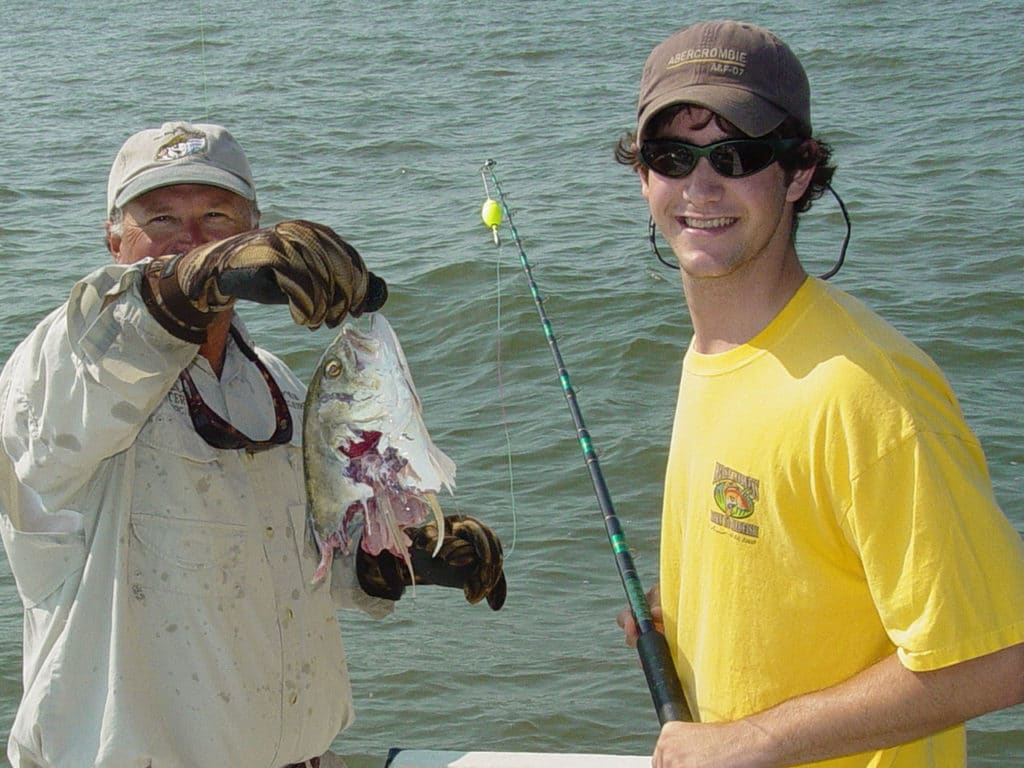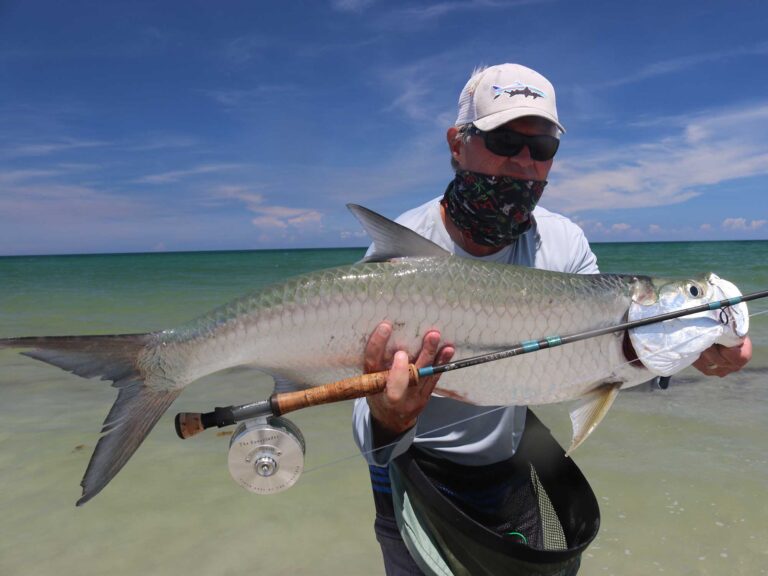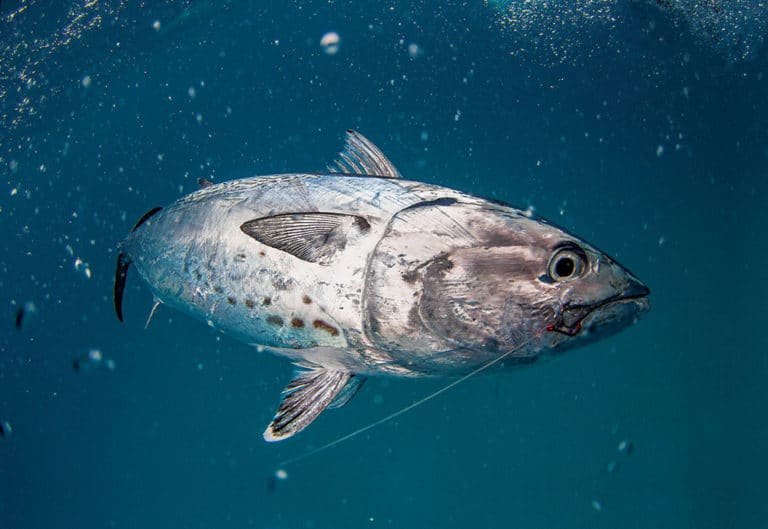
1) Getting Your Catch Eaten by A Shark
The old maxim about death and taxes applies as much to fishing the flats as to everyday life, because at some point, a shark preying on your hooked fish is inevitable. One last-ditch option is to open the bail, allowing the fish to swim free and potentially outmaneuver a shark, but there’s no guarantee that it’ll escape or even stay hooked. About all an angler can do is shed two tears—one for the fish that just became shark sushi and the other for himself.
Unfortunately, getting sharked is not something we can predict, so we fish. Of course, if we see a big lemon or bull or hammerhead swimming circles, then we either wait or move, preferring not to pay the flats tax.
But no matter how careful you or your guide are, you will lose fish to sharks. At such times, a good cry might just make you feel better. —Doug Olander
2) Treble Hooks
I stood in the dark, cursing the 18 pounds of angry striped bass attached to my left hand. In my haste to get the fish back in the water, the pliers slipped, and the front treble of the Chug Bug found its way into the flesh beneath my thumb. With each pulse of the fish, the hook dug deeper. And in that moment, I vowed to switch all my treble hooks to singles. —Joe Albanese
3) Taking Bad Fish Photos
Want to take better fish photos? Whether for your social media feed or a glossy publication, good photos will get you noticed and earn compliments. What about bad photos? Well, we hate them. Here’s why, along with six simple tips to make them better.
Don’t Look at the Lens. Want to focus attention on the catch? Then have the angler look the fish in the eyes, not at the camera. This makes people visually home in the fish, which is what your photography should be all about.
Explore New Angles. Too many photos are taken at eye level, and that’s pretty boring. Try shooting from down low, or have the angler hold the fish over the side of the boat while you lean out and shoot back. Try a different angle, and it will make your photos better.
Keep It Tight. Crop in close on the angler and fish. That helps bring the subject into tight focus for better photos. Why you’re at it, avoid objects like rods and other anglers in the background that can distract from the main subject.
Capture the Life. Don’t wait until the fish is dead, pie-eyed and dull in color to take a picture. Fish that are fresh from the water, full of vibrant color and clearly alive make for the best photos.
Avoid Carnage. Please don’t take photos of epic kills, decks full of dead and bloody fish. Not only are these bad photos, they reflect poorly on anglers and only serve to reinforce the misguided notion among anti-fishing groups that recreational fishing depletes marine resources.
No Hand Signs. OK, this is my personal pet peeve—anglers who throw hand signs while holding fish. Tell your subject avoid hand signs, be it thumbs up or hang-loose, and keep the focus on the fish, not the angler. —Jim Hendricks
4) Overly Complicated Knots If You Don’t Need Them
One of the most important connections anglers make these days is their braided line-to-fluorocarbon leader knot. It’s also the most likely of the knots between your reel and hook or lure to fail. I would be the last fisherman to say it’s not worth the effort to tie an intimidating FG or PR bobbin knot. When properly tied, both offer strength close to 100 percent of the braided-line rating.
But as noted, these knots do take time. Trying to tie an FG or PR knot in a boat rocking in a stiff chop can be challenging and even frustrating, versus tying them at home indoors, with no rush and under a good light. I think every serious angler should take advantage of the line-to-leader super knots since they are far stronger.
That said, old-standby knots that anyone can tie pretty quickly, such as double unis, surgeons and Albertos will work well enough if the angler remembers to lighten up on his drag. There will always be circumstances when you don’t want to take the time to tie an FG or PR knot, such as when your main line parts in the middle of a hot bite and getting reconnected in a hurry is of great importance. But at the least, tie these easier knots with care, taking no shortcuts that might cost you additional strength. Go with what you know and are good at.
What you’re targeting is also a consideration. Permit, bull redfish or giant trevally are certainly going to put any knot to the test, and the super knots will be to your advantage. If you’re after seatrout, flounder or spotted bay bass, a quick-and-easy knot can be enough. —Doug Olander
5) Running Aground
I’d rather catch one fish in a spot I just discovered than 10 somewhere I’ve already fished. That proclivity leads me to constantly explore the vast Louisiana marsh. But venturing into new water comes with substantial risk: running your boat aground. Sometimes I find something on a map that looks particularly juicy, but when I get there, it’s shallower than a middle-school girl’s Instagram posts.
I carry a telescoping push pole, which has rescued me dozens of times from spending a night in the marsh—but I’ve come mighty close. And to be sure, a full night exposed to the elements in the backwaters would be the kind of torture that should be banned by the Geneva Convention.
At dusk, the flying teeth known as no-see-ums would take a chunk out of every millimeter of exposed flesh. I’ve had day trips where the clouds of them were so thick, they climbed in my nostrils and ear canals, and filled my mouth every time I tried to speak. Then, after dark, the mosquitoes would pick up where the marsh gnats left off, sucking enough blood to earn me a donor T-shirt.
So, don’t run aground. Your boat and body will thank you. —Todd Masson
6) The Wind
Your phone is exploding with pictures from your friends of extra-large fish caught on pristine, calm waters while you’re stuck at your desk. You count the minutes until you’re free… But as soon as you hitch up the boat, the wind kicks up. Like clockwork, that gale comes in from the north, spreading whitecaps across the bay and putting the fish down. But don’t worry, the fan will turn off as soon as you punch that clock. —Joe Albanese
7) Dehydration
There I was, in a panga at Alphonse Island in the Seychelles. Our guide Wayne said to me quietly, “You should drink some water.” It was Day Three on this Indian Ocean flat. I took a pull from the Yeti water bottle just to appease him, then it was back to it. The day of our departure, I felt an urge to pee. And it never left. I’d picked up a urinary tract infection just in time for my 14-hour flight from Dubai to New York. —Shawn Bean








